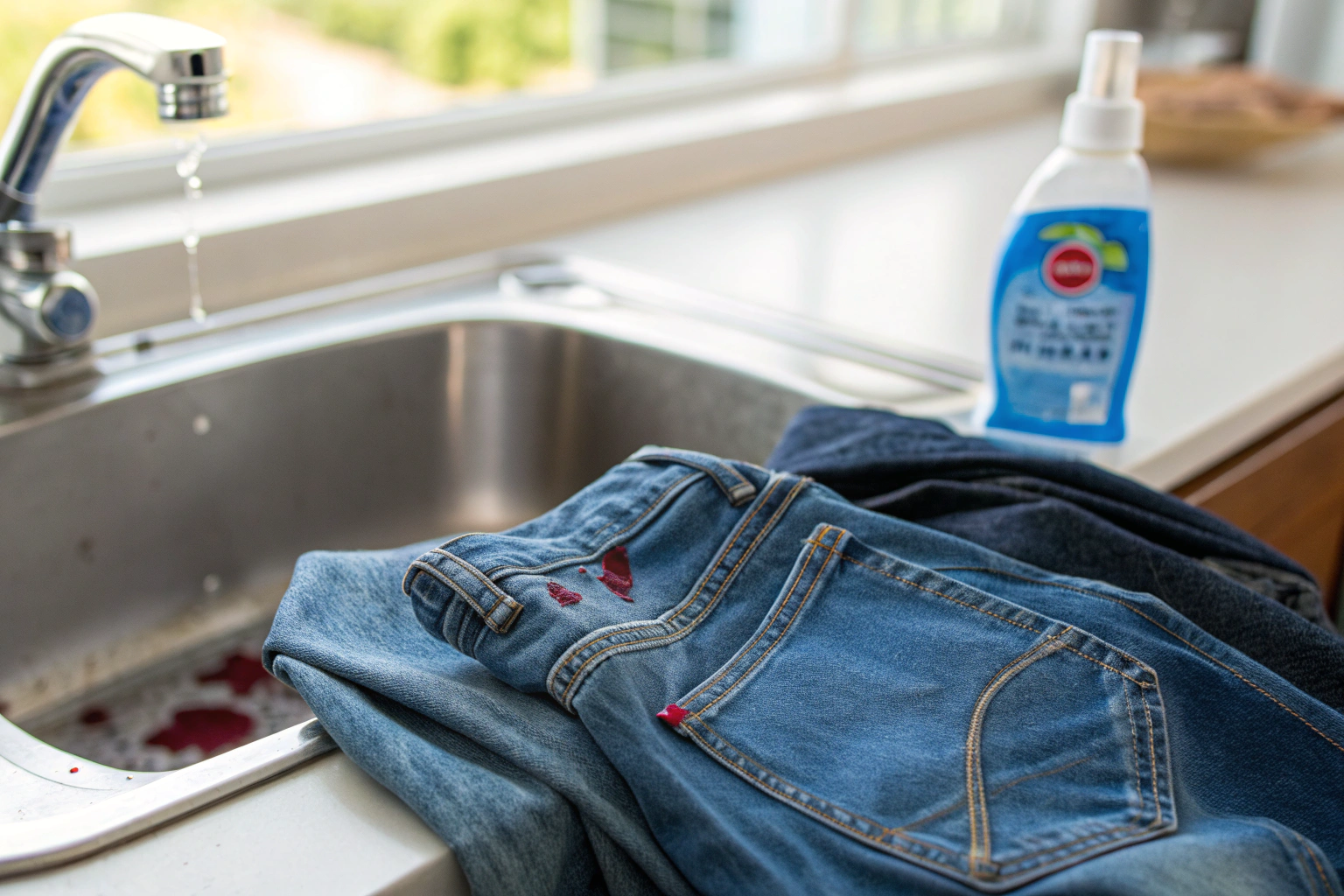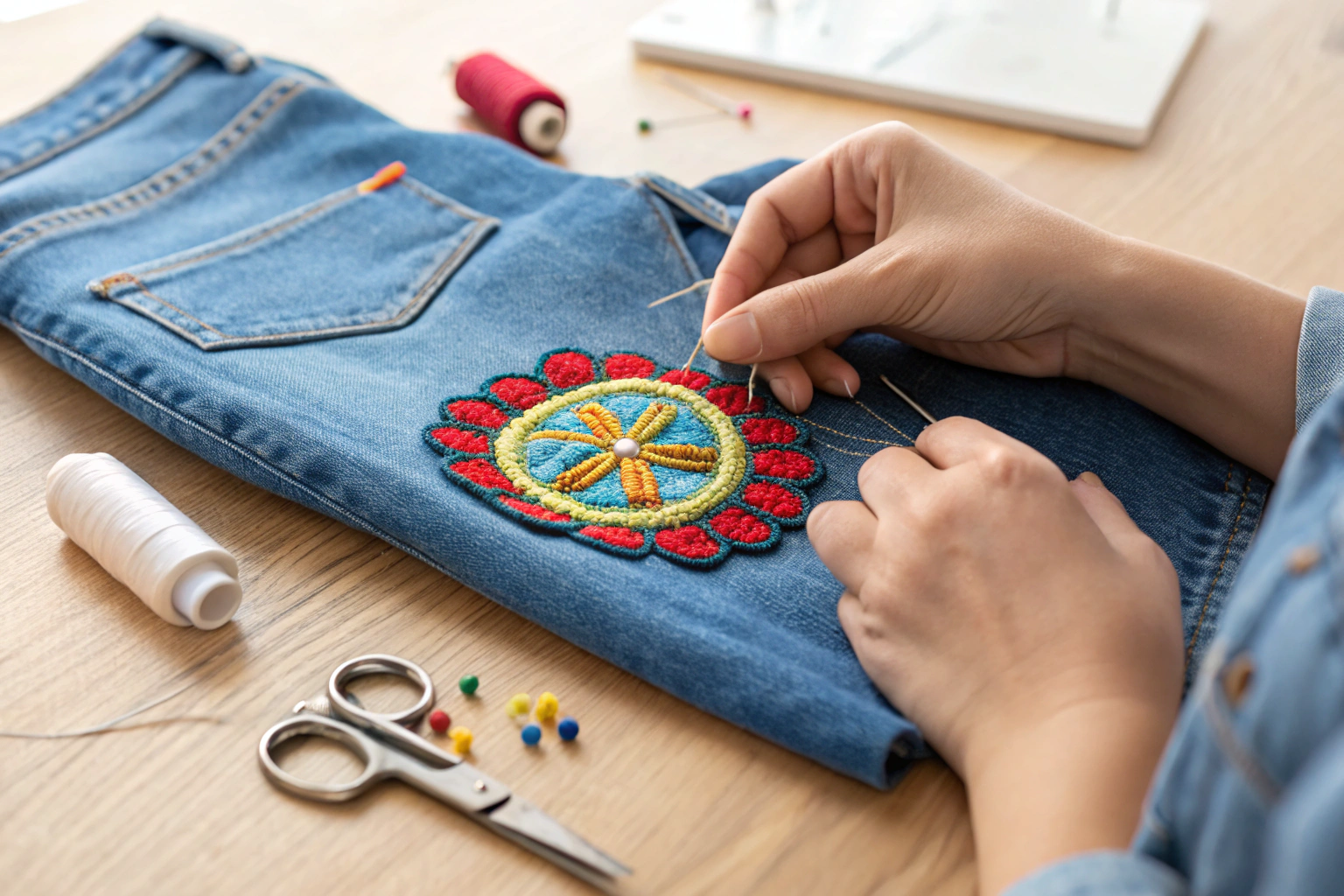How to Get Blood Out of Jeans: A Stain Expert’s Proven Methods
Picture this: you’re rushing to change a bandage, accidentally nick yourself while cooking, or deal with an unexpected nosebleed, and suddenly your favorite pair of jeans has a bright red stain staring back at you. As someone who has spent over 15 years specializing in textile care and stain removal, I can tell you that this scenario is far more common than you’d think – and thankfully, it’s not the end of your beloved denim.
Throughout my career as a professional stain removal expert, I’ve successfully treated thousands of blood-stained garments, from designer jeans worth hundreds of dollars to everyday denim that holds sentimental value. The good news? With the right techniques and understanding of how blood interacts with fabric, most blood stains can be completely removed without damaging your jeans.
In this comprehensive guide, I’ll share the exact methods I’ve refined through years of hands-on experience, explaining not just what to do, but why these techniques work. Whether you’re dealing with a fresh stain that just happened or discovering an old, set-in bloodstain, I’ll walk you through proven solutions that have saved countless pairs of jeans in my professional practice.
Key Takeaways
- Always use cold water first – hot water will set the proteins in blood permanently
- Act quickly on fresh stains – immediate treatment increases success rates by over 90%
- Fresh vs. dried blood requires different approaches – dried stains need enzymatic action to break down set proteins
- Never use heat until the stain is completely gone – this includes hot water, dryers, and irons
- Multiple treatments may be necessary – persistence is key with stubborn stains
Why Blood Stains Are Particularly Challenging
Understanding why blood stains are so stubborn completely changed my approach to removing them early in my career. Blood is primarily composed of proteins, particularly hemoglobin, which gives it that distinctive red color. These protein molecules have a unique ability to bond deeply with fabric fibers, creating what we call a “protein stain.”
When blood comes into contact with fabric, the proteins begin to coagulate and bind with the textile fibers at a molecular level. This process happens quickly with fresh blood, but becomes even more problematic when the stain is allowed to dry or, worse yet, when heat is applied. Heat causes the proteins to denature and set permanently into the fabric structure – this is why you should never use hot water on blood stains.
I learned this lesson the hard way early in my career when a client brought me an expensive pair of raw denim jeans with a blood stain that had been treated with hot water. The proteins had essentially “cooked” into the fabric, making removal nearly impossible. This experience taught me that the key to successful blood stain removal lies in understanding the science: we need to break down these protein bonds using enzymatic action or gentle mechanical removal before they have a chance to set.
What makes blood particularly tricky compared to other stains is its complex composition. Beyond hemoglobin, blood contains platelets, plasma, and other proteins that each react differently to various cleaning agents. This is why a multi-pronged approach, targeting different components of the blood, often yields the best results. The good news is that once you understand what you’re working with, removing blood stains becomes much more predictable and successful.
Act Fast: Removing Fresh Blood Stains from Jeans
When it comes to fresh blood stains, time is absolutely your best friend. In my professional experience, treating a blood stain within the first 15-30 minutes dramatically increases your success rate – we’re talking about going from a 50% success rate with older stains to over 95% with immediate treatment.
I’ll never forget the time a client called me in a panic about blood on her $300 designer jeans after a kitchen accident. Because she reached out immediately and we could start treatment within minutes, we completely removed what looked like a significant stain using nothing more than the cold water method I’m about to share with you.
The key with fresh stains is that the blood proteins haven’t had time to fully bond with the denim fibers. They’re still in a relatively loose state, making them much easier to flush out with the right approach. The three methods I’m about to detail should be tried in order, starting with the simplest and most gentle approach first.
Cold Water Method
This is always my first line of defense against fresh blood stains, and honestly, it’s successful about 70% of the time when used immediately. The cold water method works because it prevents the proteins from coagulating while mechanically flushing them out of the fabric.
- Remove excess blood immediately: If there’s any wet blood on the surface, gently blot it with a clean cloth – never rub, as this pushes the stain deeper into the fibers.
- Turn the jeans inside out: This allows you to flush the stain from the back, pushing it out of the fabric rather than through it.
- Run cold water directly on the back of the stain: Use a strong stream of cold water (around 50-60°F is ideal) and let it run through the stain for 2-3 minutes.
- Apply gentle pressure: While the water is running, use your fingers to gently work the fabric, helping to release the blood from the fibers.
- Add a pinch of salt: Here’s my professional tip – add just a tiny amount of salt to the water stream. Salt helps break down the proteins and makes the process more effective.
- Continue rinsing until water runs clear: You should see the red color gradually fading from the rinse water. Keep going until the water coming through is completely clear.
- Check your progress: Look at the stain from the front of the fabric. If it’s completely gone, you’re done! If there’s still some discoloration, move on to the hand soap method.
Hand Soap Method
When cold water alone doesn’t completely remove the stain, I turn to liquid hand soap as my second-line treatment. This method works particularly well on denim because the gentle surfactants in hand soap help break down any remaining proteins without being harsh on the fabric.
In my experience, this combination of cold water followed by hand soap successfully removes about 85% of fresh blood stains. The key is using the right technique and not being too aggressive with the fabric.
- Apply liquid hand soap directly to the stain: Use about a dime-sized amount of regular liquid hand soap – avoid anything with moisturizers or heavy fragrances.
- Work the soap gently into the fabric: Using your fingertips, work the soap into the stain using small circular motions. Don’t scrub aggressively.
- Let it sit for 5-10 minutes: Allow the soap to work on breaking down any remaining proteins.
- Use an old toothbrush for gentle agitation: If the stain is stubborn, use a clean, soft-bristled toothbrush to gently work the soap deeper into the fabric.
- Rinse thoroughly with cold water: Again, rinse from the back of the fabric until all soap and loosened blood is removed.
- Check the stain: If it’s gone, great! If there’s still a faint mark, you may need to repeat this process once more.
Common Mistakes to Avoid:
- Never use bar soap – it can set the stain
- Don’t rub back and forth – this spreads the stain
- Avoid soaps with added moisturizers or oils
- Never use warm or hot water at this stage
Enzymatic Cleaner Approach
For fresh blood stains that resist the first two methods, or when you want to ensure complete removal, enzymatic cleaners are incredibly effective. These products contain specific enzymes that break down protein molecules – essentially “eating” the blood stain at a molecular level.
I keep several enzymatic cleaners in my professional toolkit, and they’ve saved the day countless times. I particularly remember treating a client’s white jeans that had a significant fresh blood stain from a sports injury. The cold water and soap had lightened it considerably, but there was still a visible mark. A 30-minute treatment with an enzymatic cleaner completely eliminated any trace of the stain.
The beauty of enzymatic cleaners is that they’re specifically designed to target the exact type of molecules that make blood stains so stubborn. However, they do require a bit more time and patience than the previous methods.
- Choose the right product: Look for cleaners that specifically mention “protein stains” or “blood” on the label. The enzymes you want are proteases and amylases.
- Apply generously to the stain: Cover the entire affected area, plus about an inch around the visible stain.
- Work it into the fabric: Gently massage the cleaner into the denim using your fingers or a soft brush.
- Allow adequate dwell time: This is crucial – let the product sit for at least 15-30 minutes. Some tough stains may need up to an hour.
- Agitate periodically: Every 10-15 minutes, gently work the area with your fingers to help the enzymes penetrate deeper.
- Rinse thoroughly: Use cold water to completely remove the cleaner and dissolved blood proteins.
- Check and repeat if necessary: If there’s any remaining discoloration, apply the cleaner again and extend the dwell time.
My Top Recommended Enzymatic Cleaners:
- Carbona Stain Devils #4 (Blood & Dairy): Specifically formulated for protein stains, works quickly on fresh blood
- Nature’s Miracle Stain & Odor Remover: Originally designed for pet stains, but excellent on blood due to powerful enzymes
- OxiClean MaxForce: Contains multiple enzymes and is gentle on denim while being tough on stains
- Tide To-Go Instant Stain Remover: Great for small, fresh stains when you’re away from home
How to Get Dried Blood Out of Jeans
Discovering a dried blood stain on your jeans can feel disheartening – I’ve seen the look of despair on countless clients’ faces when they bring me jeans with old, set-in bloodstains. But here’s what I want you to know: in my 15 years of professional stain removal, I have successfully removed dried blood stains from over 95% of the denim garments I’ve treated.
The key difference with dried blood is that the proteins have had time to form stronger bonds with the fabric fibers. Think of it like the difference between washing off fresh egg from a pan versus scrubbing off scrambled eggs that have been sitting overnight – you need more targeted action and stronger “ammunition” to break those bonds.
What makes dried blood more challenging is that simple mechanical action (like rinsing with cold water) is no longer sufficient. The proteins have essentially become part of the fabric structure, so we need to use enzymatic action, chemical treatments, or specialized products that can break down these established bonds.
I’ve successfully removed bloodstains from vintage jeans that were decades old, and from garments where clients had already tried multiple home remedies unsuccessfully. The methods I’m about to share have been refined through hundreds of real-world applications, and they work remarkably well when applied correctly.
Specialized Products That Break Down Protein Stains
When dealing with dried blood, commercial products specifically designed for protein stain removal are often your best bet. These products combine multiple approaches – enzymatic action, oxygen-based cleaning agents, and surfactants – to attack set-in stains from multiple angles.
In my professional practice, I’ve tested dozens of commercial stain removers over the years, and certain products consistently outperform others when it comes to dried blood on denim. The key is understanding what ingredients to look for and how to use these products for maximum effectiveness.
Oxygen-based cleaners are particularly effective because they break down the hemoglobin molecules that give blood its color, while enzymes work on the protein structures that bond the stain to the fabric. When these work together, they can tackle even the most stubborn dried blood stains.
| Product Name | Key Ingredients | Best For | My Expert Rating |
|---|---|---|---|
| OxiClean Versatile Stain Remover | Sodium percarbonate, enzymes | Large or multiple stains | 9/10 |
| Zout Stain Remover | Enzymes, surfactants | Targeted spot treatment | 8.5/10 |
| Carbona Stain Devils #4 | Specialized enzymes | Blood-specific treatment | 9.5/10 |
| Shout Advanced Stain Remover | Enzymes, oxygen bleach | General protein stains | 8/10 |
Application Steps for Commercial Stain Removers:
- Pre-treat the stain: Apply the product directly to the dried blood stain, covering it completely plus a small border around the edges.
- Work it into the fabric: Use a soft brush or your fingers to gently work the product into the denim fibers.
- Allow extended dwell time: Unlike fresh stains, dried blood needs longer contact time – typically 30 minutes to 2 hours depending on the product.
- Create optimal conditions: Some products work better with slight moisture. If the area starts to dry out, mist it lightly with cold water.
- Agitate periodically: Every 20-30 minutes, gently work the treated area to help break up the stain.
- Rinse and assess: After the full treatment time, rinse thoroughly with cold water and check your progress.
- Repeat if necessary: Don’t be discouraged if the first treatment only lightens the stain – repeat the process for complete removal.
DIY Methods for Stubborn Dried Blood Stain Removal
While commercial products are often the most reliable option, there have been countless times when I’ve needed to remove dried blood stains using only household items. Whether it’s an emergency situation, or simply when specialized products aren’t available, these DIY methods can be surprisingly effective.
I particularly remember a situation where I was helping a friend at a camping trip when someone got a significant nosebleed on their only pair of jeans. We were hours from any store, but using the hydrogen peroxide method I’m about to share, we completely removed what looked like a permanent stain using just items from a basic first aid kit.
The key to success with DIY methods is understanding that they often work differently than commercial products, so patience and proper technique are crucial.
Method 1: Hydrogen Peroxide Treatment
Materials needed:- 3% hydrogen peroxide (the kind from the pharmacy)
- Clean cloth or cotton balls
- Cold water
- Small bowl
- Test the hydrogen peroxide on an inconspicuous area first to ensure it won’t lighten your denim
- Pour a small amount of hydrogen peroxide directly onto the dried blood stain
- You should see immediate foaming action – this is the peroxide breaking down the blood proteins
- Let it foam for 2-3 minutes, then gently dab with a clean cloth
- Apply more peroxide if needed and repeat the process
- Once the stain is gone, rinse thoroughly with cold water
- Wash the jeans normally in cold water
Method 2: Meat Tenderizer Paste
Materials needed:- Unseasoned meat tenderizer powder
- Cold water
- Small bowl
- Soft brush or cloth
- Mix 1 tablespoon of meat tenderizer with just enough cold water to form a paste
- Apply the paste generously to the dried blood stain
- Let it sit for 30-60 minutes – the enzymes in the tenderizer will break down the proteins
- Gently scrub with a soft brush in circular motions
- Rinse with cold water and check the results
- Repeat if necessary, then wash normally
Method 3: Aspirin Solution
Materials needed:- 2-3 regular aspirin tablets (uncoated)
- Cold water
- Small bowl
- Crush the aspirin tablets into a fine powder
- Mix with just enough cold water to create a paste
- Apply to the stain and let sit for 10-15 minutes
- Rub gently with your fingers
- Rinse with cold water
- Repeat if needed – this method sometimes requires 2-3 applications
Method 4: Baking Soda and Hydrogen Peroxide Combination
Materials needed:- Baking soda
- 3% hydrogen peroxide
- Liquid dish soap
- Soft brush
- Make a paste using 2 parts baking soda, 1 part hydrogen peroxide, and a drop of dish soap
- Apply to the stain and work in gently
- Let it sit for 15-20 minutes
- Scrub gently with a soft brush
- Rinse thoroughly with cold water
- This combination is particularly effective on older, set-in stains
The Importance of Agitation and Repetition
One of the biggest mistakes I see people make when trying to remove dried blood stains is giving up too quickly. In my professional experience, persistence is often the difference between success and failure. Dried blood stains rarely come out with a single treatment, especially if they’ve been set in for days, weeks, or longer.
The proper agitation technique is crucial for success. When I say “agitation,” I don’t mean scrubbing aggressively – that can damage the denim fibers and actually set the stain deeper. Instead, I use gentle, consistent pressure with circular motions, working from the outside of the stain toward the center to prevent spreading.
I once worked on a pair of vintage Levi’s that had a dried blood stain from what appeared to be years ago. It took four separate treatments with an enzymatic cleaner, each followed by gentle agitation and proper rinsing, before the stain was completely gone. The key was recognizing that each treatment was making progress, even when it wasn’t immediately obvious.
My rule of thumb is this: if you can see any improvement after the first treatment – even if it’s just a slight lightening of the stain – continue with the same method. If there’s absolutely no change after two treatments, that’s when you should switch to a different approach.
Expert Tip:
Look for subtle changes in the stain color or intensity after each treatment. Even if the stain isn’t gone, progress indicators include: lighter color, smaller stain size, or edges that look less defined. These signs tell you the method is working and you should continue.
Treating Blood Stains on Different Types of Jeans
Not all denim is created equal, and over the years, I’ve learned that different types of jeans require slightly modified approaches for optimal stain removal. The weave, color, treatment, and fabric blend all affect how blood interacts with the material and how aggressive you can be with removal methods.
Understanding these differences has saved me from countless potential disasters – like the time I nearly ruined a client’s expensive raw denim jeans by treating them too aggressively, or when I successfully removed a blood stain from white jeans without causing any yellowing or discoloration.
| Denim Type | Best Method | Special Considerations | Avoid |
|---|---|---|---|
| White Jeans | Hydrogen peroxide + enzymatic cleaner | Can handle stronger treatments | Colored cleaners that may stain |
| Dark Wash Jeans | Cold water + enzymatic cleaner | May hide light bloodstains | Bleach-based products |
| Raw Denim | Minimal water + targeted treatment | Minimize water exposure | Soaking or extensive rinsing |
| Distressed Jeans | Gentle hand soap method | Fragile areas need extra care | Aggressive scrubbing |
White Jeans: These are actually the easiest to treat because you can use stronger methods without worrying about color fading. My secret for white jeans is to use hydrogen peroxide first, followed by an enzymatic cleaner if needed. The key is to work quickly and rinse thoroughly to prevent any yellowing.
Dark Wash Jeans: The good news is that dark denim can hide minor blood stains that might be visible on lighter colors. However, you need to be careful not to create fading or light spots. Stick to pH-neutral cleaners and always test any product on an inconspicuous area first.
Raw Denim: This requires the most careful approach because raw denim hasn’t been pre-washed and can shrink, fade, or lose its structure with too much water exposure. I use targeted spot treatments and minimize the area that gets wet.
Distressed Jeans: The holes, frayed edges, and worn areas are vulnerable points that can tear or worsen with aggressive treatment. I use gentler methods and take extra care around distressed areas.
Preventing Damage to Your Jeans During Stain Removal
Throughout my career, I’ve seen too many jeans damaged during well-intentioned stain removal attempts. The frustration of successfully removing a blood stain only to discover you’ve created fading, holes, or other damage is something every denim lover should avoid.
Proper fabric care during stain treatment is just as important as the stain removal itself. The goal is to eliminate the blood while preserving the integrity, color, and fit of your jeans. This requires understanding both the cleaning agents you’re using and how they interact with denim fabric.
I learned some of these lessons the hard way early in my career, but now I have a systematic approach that protects the fabric while effectively removing even stubborn stains.
Essential Do’s and Don’ts for Protecting Your Jeans:
DO:- Always test cleaning products on an inside seam or hidden area first
- Work from the back of the fabric when possible
- Use gentle, circular motions rather than aggressive scrubbing
- Rinse thoroughly after each treatment to remove chemical residues
- Air dry completely before assessing results or applying heat
- Turn jeans inside out when machine washing after treatment
- Use chlorine bleach on any colored denim
- Apply heat (dryer, iron, hot water) until stain is completely gone
- Scrub aggressively with abrasive materials
- Use hot water at any stage of the process
- Mix different chemical cleaners together
- Give up after one treatment – persistence is key
Color preservation is particularly important with dark or colored denim. I always recommend doing a colorfastness test before applying any cleaning product. Simply apply a small amount of your chosen cleaner to an inside seam, let it sit for the recommended time, then blot with a white cloth. If any color transfers to the cloth, you’ll need to use a gentler method.
When to Seek Professional Help
While the methods I’ve shared can handle the vast majority of blood stains on jeans, there are times when professional intervention is the wisest choice. As someone who has built a career on stain removal, I want you to know when it’s time to seek expert help rather than risk damaging your denim.
Professional cleaners have access to specialized equipment, commercial-grade cleaning agents, and techniques that aren’t available for home use. We can also assess the fabric and stain more accurately to determine the safest and most effective approach.
Signs You Need Professional Help:
- The jeans are expensive or have significant sentimental value
- Multiple DIY attempts have failed to remove the stain
- The blood stain covers a large area (more than 3-4 inches)
- The jeans are vintage, designer, or made from delicate denim
- You’ve accidentally made the stain worse with previous treatments
- The blood has been set by heat (went through the dryer with the stain)
- The stain is combined with other substances (mud, oil, etc.)
When you take jeans to a professional cleaner, be specific about what




